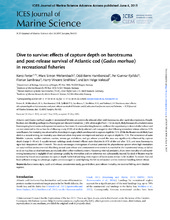| dc.description.abstract | Atlantic cod (Gadus morhua) caught in recreational fisheries are commonly released, often with barotrauma after rapid decompression. Mouth-hooked, non-bleeding cod kept in a floating net pen showed mortalities ≥40% when angled from >50 m depth, likely because of cumulative stress from ongoing barotrauma and exposure to warm surface water. In a natural setting, however, cod have the opportunity to descend after release and are not restricted to the surface. In a follow-up study, 97.8% of similarly selected cod managed to dive following immediate release, whereas 2.2% were floaters. No mortality was observed for divers kept in cages, which were lowered to capture depth for 72 h. While the floaters would likely have died in a natural setting, no mortality was observed when they were recompressed and kept at capture depth for 72 h. The occurrence of swim bladder ruptures, swollen coelomic cavities, venous gas embolisms, and gas release around the anus was significantly influenced by capture depth (range 0–90 m). A supplementary radiology study showed inflated swim bladders in 87% of the cod after 72 h, and most barotrauma signs had disappeared after 1 month. This study encourages investigation of survival potential for physoclistous species when high mortalities are assumed but undocumented. Matching natural post-release and containment environment is essential in the experimental setup, as failure to do so may bias survival estimates, particularly when a thermocline is present. Assuming minimal predation, short-term mortality of cod experiencing barotrauma is negligible if cod submerge quickly by themselves and are otherwise not substantially injured. Survival of floaters may be increased by forced recompression to capture depth. Sublethal and long-term impacts of barotrauma remain to be studied. To ensure that cod have sufficient energy to submerge, anglers are encouraged to avoid fighting the fish to exhaustion and to minimize handling before release. | en_US |

